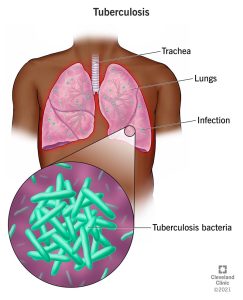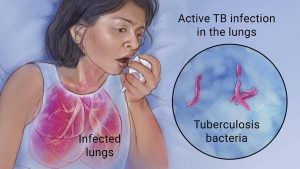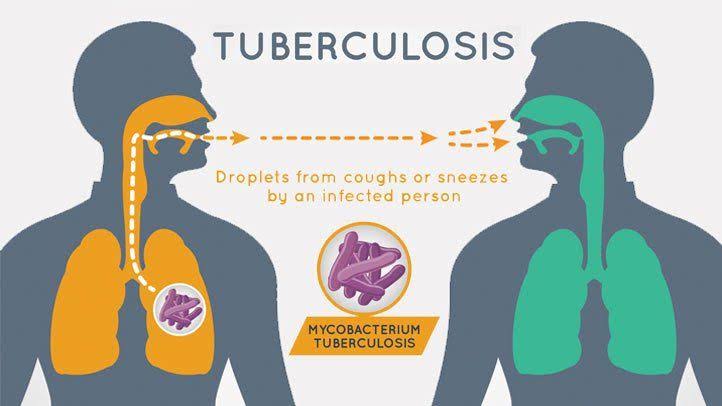In the bustling city of Mumbai, amidst the cacophony of honking cars and chattering crowds, lived Asha—a vibrant young woman with dreams of becoming a renowned artist. Her days were filled with colors and canvases, and her nights were alive with the hum of creativity. But slowly, insidiously, a whispering malady began to cast a shadow over her life. It started with a mild cough, so subtle that it seemed insignificant. Yet, as weeks turned into months, Asha found herself increasingly breathless, her energy sapped, her dreams fading. The culprit? Tuberculosis.

What Is Tuberculosis?

Tuberculosis (TB) is a contagious infection that usually attacks your lungs. It can also spread to other parts of your body, like your brain and spine. A type of bacteria called Mycobacterium tuberculosis causes it.
Types of Tuberculosis
1. Latent TB. You have the germs in your body, but your immune system keeps them from spreading. You don’t have any symptoms, and you’re not contagious. But the infection is still alive and can one day become active. If you’re at high risk for reactivation, your doctor will give you medications to prevent active TB. This usually happens if you have HIV, you had an infection in the past 2 years, your chest X-ray is unusual, or your immune system is weakened.
2. Active TB. The germs multiply and make you sick. You can spread the disease to others. Some 90% of active cases in adults come from a latent TB infection.
3. Active TB outside the lungs. A tuberculosis infection that spreads from your lungs to other parts of the body is known as extrapulmonary tuberculosis. Your symptoms will depend on which part of your body the infection affects.
Symptoms

Latent TB: A person with latent TB will have no symptoms, and no damage will show on a chest X-ray. However, a blood test or skin prick test will indicate that they have TB infection.
Active TB: An individual with TB disease may experience a cough that produces phlegm, fatigue, a fever, chills, and a loss of appetite and weight. Symptoms typically worsen over time, but they can also spontaneously go away and return.
Early warning signs
A person should see a doctor if they experience:
a persistent cough, lasting at least 3 weeks
phlegm, which may have blood in it, when they cough
a loss of appetite and weight
a general feeling of fatigue and being unwell
swelling in the neck
a fever
night sweats
chest pain
Causative Organisms
1.Mycobacterium tuberculosis: The primary causative bacterium.
2.Mycobacterium bovis: Can cause TB in humans, usually transmitted from infected cattle.
3.Mycobacterium africanum: Primarily found in parts of Africa.
Risk Factors
– Close contact with an individual with active TB.
– Weakened immune system (e.g., HIV/AIDS).
– Malnutrition.
– Living or working in crowded conditions (e.g., prisons, homeless shelters, refugee camps).
– Substance abuse (e.g., alcohol and drugs).
– Poor living conditions and inadequate healthcare access.
– Age (infants and the elderly are at higher risk).
Prevention
1.Vaccination: Bacillus Calmette-Guérin (BCG) vaccine.
2.Screening and Testing: Regular screening, especially in high-risk populations.
3.Infection Control: Using masks, ensuring good ventilation, and practicing good hygiene.
4.Public Health Measures: Improving living conditions, nutrition, and access to healthcare.
5.Education and Awareness: Informing communities about TB symptoms and the importance of early diagnosis and treatment.
Treatments
1.Antibiotic Therapy: A combination of antibiotics, typically including isoniazid, rifampicin, ethambutol, and pyrazinamide.
2.Duration: Treatment usually lasts for six to nine months.
3.Directly Observed Therapy (DOT): Health workers supervise patients to ensure they complete their treatment regimen.
4.Drug-Resistant TB: Requires longer and more complex treatment with second-line drugs.
Prognosis
Positive Outlook with Treatment: Most individuals recover fully if they adhere to their treatment regimen.
Drug-Resistant TB: More difficult to treat, with a higher risk of complications and death.
Untreated TB: Can be fatal, particularly in individuals with weakened immune systems or inadequate access to healthcare.
Long-Term Monitoring: Regular follow-ups to ensure the disease does not recur.

